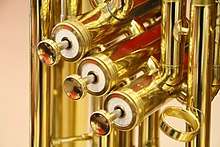Brass instrument valve
Brass instrument valves are valves used to change the length of tubing of a brass instrument allowing the player to reach the notes of various harmonic series. Each valve pressed diverts the air stream through additional tubing, individually or in conjunction with other valves. This lengthens the vibrating air column thus lowering the fundamental tone and associated harmonic series produced by the instrument. Valves in brass instruments require regular maintenance and lubrication to ensure fast and reliable movement.

Piston valve

The first piston-valved musical instruments were developed just after the start of the 19th century. The Stölzel valve (invented by Heinrich Stölzel in 1815) was an early variety. The piston valve found in the majority of valved brass instruments was invented in 1838 and patented in 1839. They are sometimes called Périnet valves after their inventor, François Périnet.[1] They work by diverting air obliquely through ports in the stock of the valve so that a loop of tubing is included in the air stream, lowering the pitch. The stock of the valve is cylindrical and moves up and down through a larger cylindrical casing.
Rotary valve
The rotary valve works using a short circular plug housed in a larger cylindrical casing. Ports are cut along one plane through the stock and direct the airflow into the lengths of tubing when the stock is rotated 90 degrees. Trombone F-attachment valves are usually rotary, with several variations on the basic design also in use, such as the Thayer axial flow valve and Hagmann valve. Horns almost always have rotary valves, and many tubas have rotary valves. Joseph Riedlin is credited with the first use of rotary valves on brass instruments in 1832.[2]
Thayer/Axial Flow valve
The Thayer valve is an alternative for the traditional rotary valve found on trombones with valve attachments. It was invented by Orla Ed Thayer (with assistance from Zig Kanstul) in 1976. It uses a conical plug, allowing a deflection of the airflow by only 25 degrees or less. An improved version of the Thayer, the Axial Flow valve uses the same principals as the Thayer, but more efficiently.
Double-piston valve
The double-piston valve, also called the Vienna valve or pumpenvalve, is a type of valve that preceded the modern single piston Périnet valve. It was first produced in a trumpet in 1821 by Christian Friedrich Sattler of Leipzig.[3] In this valve type, the simultaneous movement of two pistons bends the air flow in two right angles to introduce an additional valve loop. These turns cause constrictions in the bore, that make the instrument harder to play, but they are still used today despite their drawbacks. At first, the two pistons were operated by a lever connected with braces, but the later Vienna model of these valves was operated by long rods connecting the pistons to spring-loaded keys on the other side of the instrument.
They are called “Vienna valves” because while they have fallen out of favor in comparison with the modern rotary valve in almost all places, they are still used almost exclusively in Vienna, Austria, where players prefer the more smooth legato and mellow, natural horn-like tone. The Vienna system was in common use in Germany on all kinds of instruments including trumpets up to 1850. Adolph Sax invented instruments with 6 independent valves 3 for each hand, but only the most dexterous musicians were able to play them.
Stölzel valve
The Stölzel valve bears the name of its inventor, Heinrich Stölzel, who first applied these valves to the french horn in 1814. Until that point, there had been no successful valve design, and horn players had to stop off the bell of the instrument, greatly compromising tone quality to achieve partial music.[5] In a Stölzel valve, the air enters through the bottom of the valve casing, up through the hollow bottom end of the piston, and through a port to the valve loop. The air is then led through an oblique port in the piston to a short tube connecting the valves where it is then directed through the second valve and out the bottom. This type of valve, however, had inherent problems. It forced the air to double back on itself and the 90 degree turns disrupted the bore, causing significant undesired back-pressure. These problems were improved upon later by the double-piston valve.[6]
References
- https://web.archive.org/web/20120425204529/http://orgs.usd.edu/nmm/UtleyPages/Utleyfaq/brassfaqPerinet.html
- http://www.public.asu.edu/~jqerics/earlval.htm
- http://orgs.usd.edu/nmm/UtleyPages/Utleyfaq/brassfaqDoublepiston.html
- Carse, Adam (2002). Musical wind instruments. Courier Dover Publications. p. 259. ISBN 0-486-42422-7.
- http://www.public.asu.edu/~jqerics/why_valve.htm
- http://www.public.asu.edu/~jqerics/earlval.htm